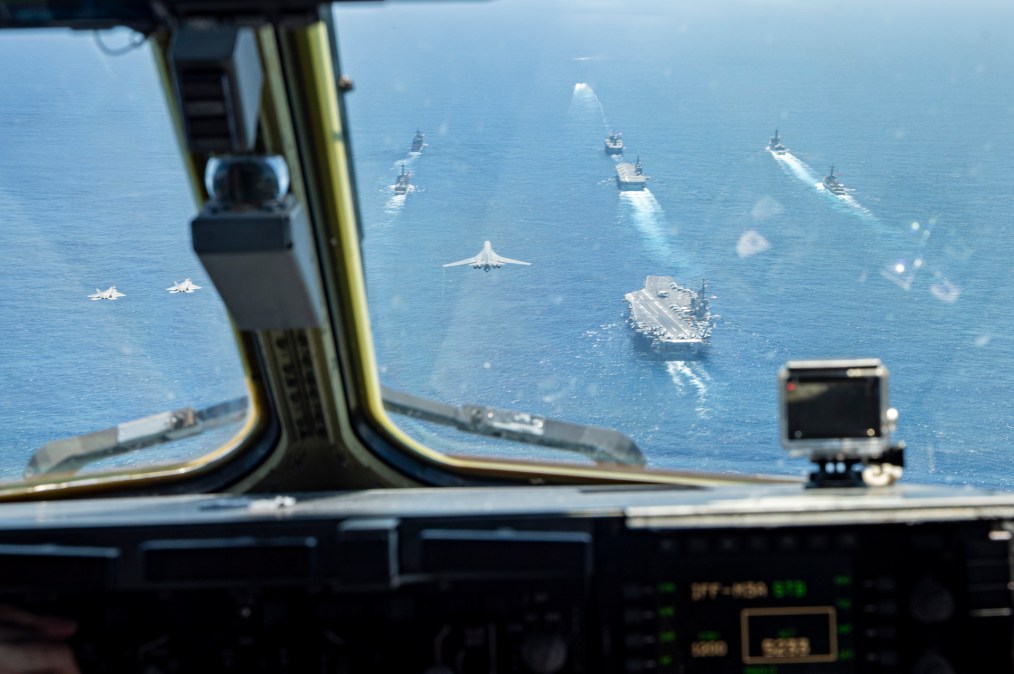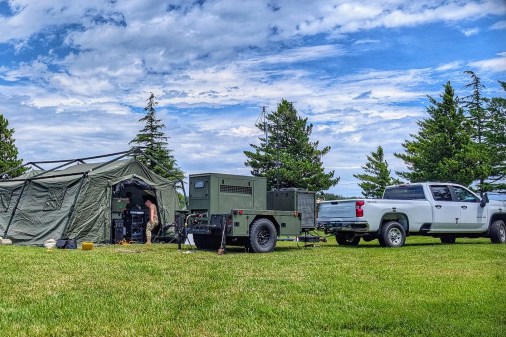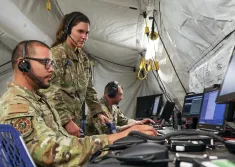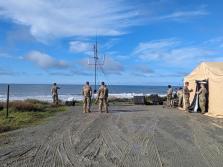Joint force, international partners, contractors test command and control capabilities in Pacific exercise

A recent exercise in the Pacific region provided the U.S. military and international partners one of the first chances to truly game out the Pentagon’s new warfare concept for connecting forces and capabilities on a grand scale.
Valiant Shield, which occurred in mid-June, is a biennial exercise focused on integration between the services in a multi-domain environment in the Pacific region. This year’s exercise, the tenth such event, involved multinational partners for the first time. It allowed American forces and foreign militaries — including participation from U.S. Space Command and U.S. Transportation Command — to focus on real-world events while testing concepts such as Combined Joint All-Domain Command and Control (CJADC2), which envisions how systems across the entire battlespace from all the services and key international partners could be more effectively and holistically networked to provide the right data to commanders, faster.
“Valiant Shield gave us a great opportunity for us to work as a joint force to conduct command and control of joint forces and joint capabilities from multiple axes, across multiple domains and integrating in allies and partners down to the tactical level,” Rear Adm. Joaquin J. Martinez de Pinillos, vice commander of 7th Fleet, said in an interview. “We really had a great opportunity to really work things both at the operational level and all the way down to the tactical level and work through both the communications, command and control, how do we share information, how do we all see the same battlespace? All those things across the joint force, which are not easy to do, we were able to exercise with great success during Valiant Shield.”
Martinez de Pinillos was not able to offer many specifics on the exercise, such as what was tested or the scenarios due to classification and sensitivities, but did note that broadly, they sought for higher headquarters — specifically the joint task force commander — to pass instructions, coordinate and synchronize joint effects from their level down to tactical units across all domains.
The key challenge they sought to address was getting all units across the joint force to be able to have the same battlefield picture and synchronize effects in space and time faster than the adversary. In fact, they conducted a series of tactical engagements in simulated environments and a live fire to demonstrate that they were able to clearly understand what the joint task force commander had in mind and then show him on the field what it would look like and how they can bring all those capabilities together.
“The things I think that we have to do is if you take a look at Ukraine and you see some of the things that the Houthis [are doing in the Middle East] and all of that, I think what you’re seeing is a speed of warfare that is incredibly fast. I think the thing that we’re going to continue to work on is just our ability to just rapidly plan faster than the enemy can, faster than they can react to us, so that we’re always causing dilemmas for the enemy as we go forward,” he explained. “I think that speed that we’re going to get with these systems, because it gives us an ability to communicate so effectively across the joint force, we’re going to continue to work on that.”
Command and control
At the heart of being able to act faster than the adversary is the ability to conduct command and control: being able to sense the environment and deliver the necessary effects against a target in the right domain by the right system operated by the right military service or international partner.
This is challenging currently as each service operates its own siloed systems that don’t necessarily plug into or talk to other systems from other services — or in some cases, its own service — much less international partners.
In a future fight, a four-star combatant commander in charge of conducting warfare and coordinating effects over an entire region must be able to pick the right capabilities based on the target set. In order to do that effectively and at the speed of conflict, they must have the ability to see each service’s capabilities and coordinate them efficiently, which is at the heart of CJADC2.
“What we were working on the JFN and the CJADC2 is, we want to make sure that everybody has that same operational picture of the battlefield,” Martinez de Pinillos said, describing the Joint Fires Network, a prototyping effort serving as a battle management platform and displaying real-time, fused, actionable threat information to joint and partner forces.
Valiant Shield was the first test of the initial prototype, which will allow geographically dispersed commanders to simultaneously plan and execute with a shared common understanding of the battlespace based on sensors from any platform to provide targeting guidance to any weapon systems, according to Lockheed Martin.
“Everybody understands, when I say the words ‘track 1,2,3,’ that that is track 1,2,3 and that is the exact same thing that everybody understands the track 1,2,3,” he added. “Sounds like a very simple thing, but it is actually a very complicated thing to actually do in execution. That’s an example of something we were able to do.”
To help test these concepts for command and control and interoperability, several defense contractors participated in Valiant Shield bringing their capabilities to play in the exercise.
“For us, the Joint All-Domain Command and Control, the JADC2 objective is fundamentally to integrate stovepiped legacy systems into a digital environment that provides a mission engine that allows for a comprehensive understanding of command and control across any domain, any service, any network,” Tom Keane, senior vice president of engineering at Anduril, said in an interview.
He said they provided capabilities for the joint force to detect, locate, track and engage across domains in response to a variety of different missions geographically deployed across the Indo-Pacom region. They provided software and hardware to help warfighters ingest data at scale, do correlation of data, provide a common operating picture and then do machine-to-machine tasking.
Anduril brought its Lattice capability to the exercise, it’s software fabric that serves as a command-and-control platform ingesting data that can then automate C2 functions resulting in a scalable battle network. The company also brought its Menace family of systems, a command and control as well as compute and communications capability.
Keane noted that Menace provided communications to support denied, degraded, intermittent and limited connectivity (DDIL), which U.S. forces will face increasingly against sophisticated adversaries that will seek to deny friendly forces.
“As you think about any large operating area, especially Indo-Pacom, supporting understanding and being able to operate in denied and degraded connectivity scenarios, is incredibly valuable,” he said.
Software company Palantir also contributed to the exercise. And while it was limited in what it could say, the company noted it provided capabilities to track and engage with targets.
“Palantir software was deployed in part to help deliver the end-to-end joint force capability of detecting, locating, tracking, and engaging units across domains and mission areas. More specifically, Palantir’s software served as the digital foundation for a common data picture that enabled users from all echelons to communicate on the same basis,” Shannon Clark, head of defense growth at Palantir Technologies, said in a statement to DefenseScoop.
“The Indo-Pacific is a uniquely complex operational environment where the software systems that give America its deterrent and defensive edge must be deployed in extreme conditions. These denied, disrupted, and limited environments are precisely the conditions that industry providers build for, and it is why we actively participate in exercises like Valiant Shield — both to ensure the defense community is proficient in the advanced technologies at their disposal, and to ensure that our software solutions are tailored to meet real-world mission needs,” Clark added.
Coordinating and shifting fires
Once targets are identified, command-and-control capabilities must assist in coordinating what service or platform will actually fire upon the target, another key pillar of CJADC2.
During the exercise, planners experimented shifting fires to different commanders and services, Martinez de Pinillos said.
“Sometimes the fires would be led by the Army, and sometimes it’d be led by the Navy, and sometimes they would be led by the Marine Corps, and sometimes they’d be led by the Air Force,” he said. “We demonstrated resiliency and flexibility in our ability to shift command and control around as the problem evolved and as the conditions in the environment and the battlefield drove us that way.”
This was also demonstrated across multiple domains, synchronizing fires from subsurface, surface, into the air and space, he added.
“That allows us to do some very, very complex operations, which is something that we practice at very hard because we know as a joint force, that is the only way that we’re going to engage in combat,” he said. “Having everybody inside that JFN single network on their own systems that they’re used to working with, but then being able to link in to that Joint Fires Network so that we’re all kind of dealing with the same piece of paper, in a virtual sense, and we’re all working off at the same piece — I think was a big piece of that and really helped us coordinate and synchronize as a joint force.”
For its part, Lockheed Martin provided live theater-level operational planning for Valiant Shield, it said in a release.
“The exercise showcased the seamless integration of Lockheed Martin’s advanced command and control functions, employing Operational Planning to coordinate real-time decision-making across the theater of operations, with all the Services and operational domains. This approach enhanced the agility and responsiveness of joint operations, using live real-time data, and producing joint tasking orders in an operationally relevant environment,” the company said.
Martinez de Pinillos explained that Valiant Shield demonstrated the ability of the joint force to understand what each other’s capabilities were.
“I think all that information sharing that was going on and how we were able to rapidly communicate that through tools like JFN, through tools like Maven [Smart System], those things really helped bring and synchronize that together because everybody was working off the same sheet of paper and working together as a team and really able to maximize their contribution, because it was easy to understand what the capabilities and limitations were of whatever piece of the puzzle that they brought to it,” he said. “That allowed us to very rapidly and seamlessly bring those things together so that we were able to commensurate those effects very, very rapidly.”






